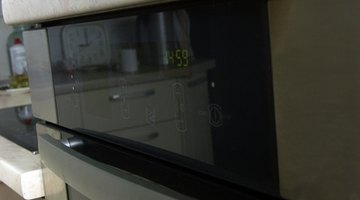Disadvantages of a Turbo Oven
Turbo ovens, which are also known as convection ovens, utilize a third heating element and fan located in the rear of the oven to circulate heated air around cooking dishes. This form of cooking yields faster cooking times and uniform results; however, turbo ovens do feature several disadvantages.
Cooking Time Adjustment

Turbo ovens prepare food much faster than traditional thermal ovens, normally 20 to 25 percent faster, according to Nancy's Kitchen. The increased cooking times may be confusing, and by not properly timing dishes, the food can become overcooked. Cooks must convert traditional oven cooking times to the more advanced turbo oven cooking times, which may take several tries and several ruined dishes. To avoid this disadvantage with a turbo oven, purchase a product with a time conversion system that converts traditional cooking times to turbo cooking times.
Price
Turbo ovens generally cost more than traditional ovens. The price variance depends not only on the manufacturer, but also on additional features the turbo oven contains. A turbo oven with the same amount of features as its traditional counterpart can typically cost $200 to $500 more, as of October 2010, according to Best Buy.
Ineffective Heating Systems
Ineffective heating systems of a turbo oven only applies to certain models. True convection ovens, which are also known as European Convection Ovens, utilize a rear heating element and fan to increase the cooking power of the oven. Not every oven marketed as a convection, or turbo, oven features this design. Typically, non-European designed ovens only feature a fan in the rear of the appliance, which does very little to enhance the cooking power of the oven; however, consumers will pay close to the same amount of money for this design.
References
Writer Bio
Jonathan McLelland has been a professional writer since 2005. He has worked as a story writer and editor for the international sitcom, “Completing Kaden,” as well as a proposal writer for various production companies. McLelland studied communication and theater at St. Louis Community College.
Photo Credits
- oven image by Evgeny Rodionov from Fotolia.com
More Articles



